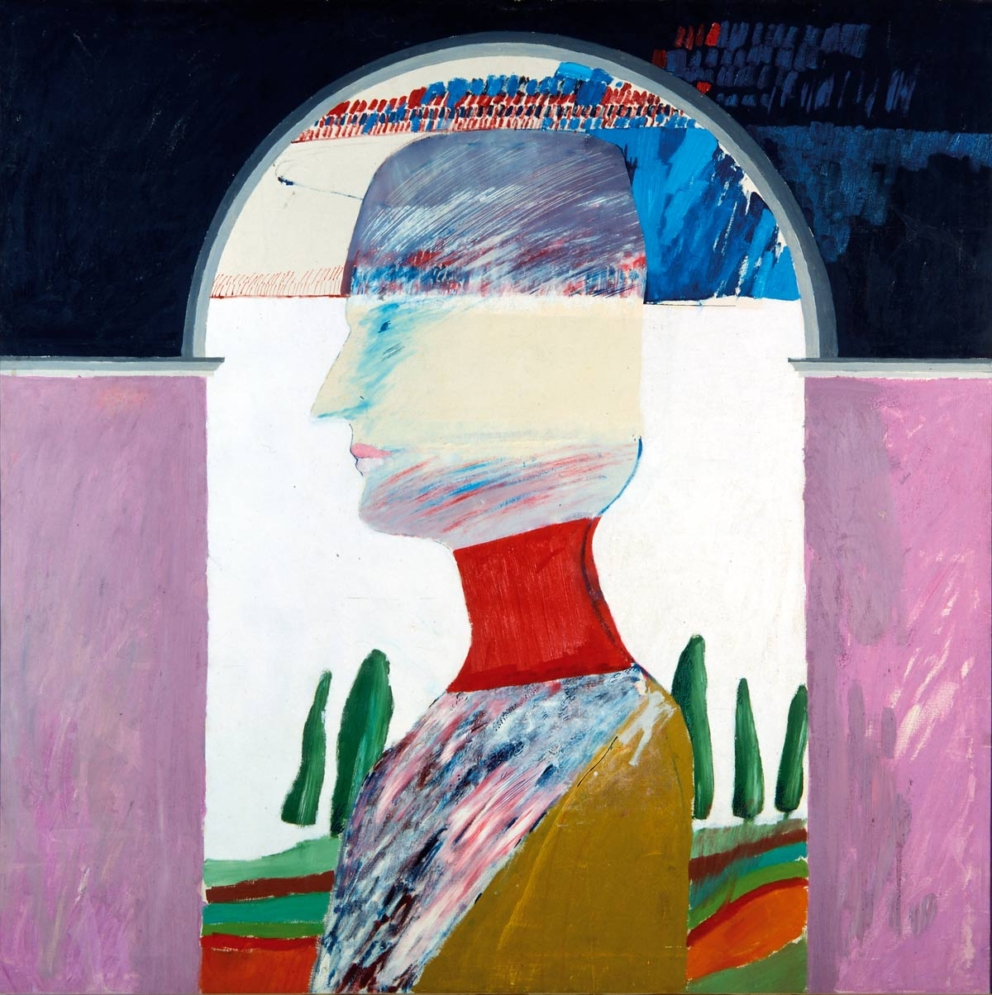
- 1963
- Canvas
- Oil
- Inv. PE216
David Hockney
Renaissance Head
Having returned from a changing trip to America, in the year in which he met Andy Warhol, David Hockney presented Renaissance Head, an imaginative subversion of renaissance iconography depicting a profile under an arch and a background landscape punctuated by Tuscan cypresses. The work is an artificial and somewhat sardonic evocation of the portraits created four centuries earlier by Piero della Francesca, a key theoretician of linear perspective whose highly rigorous and detailed paintings obeyed complex mathematical and geometrical structures. Hockney recuperated this silhouette, whilst reacting against the context that gave rise to it, which he justified as follows: «I was well able to draw figures in an academic style, but that wasn’t what I wanted to do in painting, so I had to return to something (…) an opposite style, a crude style, because I liked the similarity with children’s art, which, in turn, resembles Egyptian art, where everything is equal».* If this discourse recalls that of Henri Matisse, forty years earlier, this parenthood is confirmed by the unfinished and negligent appearance of the work’s execution, the sharing of the same chromatic exuberance and the aversion to superfluous information, and the replacement of perspective with a one-dimensional plane on which everything co-exists on an equal level.
The painting genre which della Francesca came to symbolise, as a scientific exercise based on drawing, was in every respect the opposite of what the English artist was attempting. For this reason, he adopted the reverse path, by renouncing drawing and heightening colour, exchanging a system of elevated intellectual conventions for a naïve and childlike representation that was more suited to strike the modern, standardised public of the metropolis. While others used bundles of tobacco and tinned preserves to create their art, Hockney preferred to tackle one of the most sophisticated painters in the Western tradition, and one of its most conventional formats, the portrait. An audacious rereading of the renaissance head, which gave birth to a new iconoclastic icon for the Swinging London.
Afonso Ramos
May 2010
* In Metamorphosis: British Art of the Sixties: Works from the Collections of the British Council and the Calouste Gulbenkian Foundation, Torino, Umberto Allemandi & Co., 2005, p. 65.
| Type | Value | Unit | Section |
| Height | 123,5 | cm | |
| Depth | 3,5 | cm | |
| Width | 124 | cm | |
| Height | 122 | cm | |
| Width | 122 | cm |
| Type | title |
| Type | signature |
| Type | date |
| Type | Acquisition |
| Pop Art: 1956-1968 |
| Milão, Silvana Editoriale, 2007 |
| Catálogo de exposição |
| Heimo Zobernig e a Colecção do Centro de Arte Moderna da Fundação Calouste Gulbenkian/ Heimo Zobernig and the Collection of the Calouste Gulbenkian Foundation Modern Art Centre; Heimo Zobernig and the Tate Colllection/ Heimo Zobernig e a Colecção da Tate |
| Lisboa/ St. Ives, 2009 |
| ISBN:978-1-85437-826-2 |
| Catálogo de exposição |
| A Ilha do Tesouro / Treasure Island |
| CAMJAP/FCG |
| Curator: CAMJAP/FCG |
| 7 de Fevereiro de 1997 a 4 de Maio de 1997 Todo o espaço expositivo do CAM - pisos 0, 1 e 01, e Galeria de Exposições Temporárias. |
| Comissários da exposição: Jorge Molder e Rui Sanches. |
| Metamorphosis - British Art of the Sixties: works from the collections of the British Council and the Calouste Gulbenkian Foundation |
| Basil & Elise Goulandris Foundation - Museum of Contemporary Art |
| Curator: Fleurette P. Karadontis |
| 26 de Junho de 2005 a 25 de Setembro de 2005 Basil & Elise Goulandris Foundation - Museum of Contemporary Art |
| Comissários da exposição: Richard Riley, British Council, London, e Ana Vasconcelos e Melo, CAMJAP-FCG, Lisboa. |
| 100 Obras de Arte Britânica Contemporânea |
| Fundação Calouste Gulbenkian |
| Curator: Fundação Calouste Gulbenkian |
Galeria de exposições temporárias, FCG |
| Exposição realizada em Janeiro 1971, na Galeria de exposições temporárias, FCG. |
| Pop Art: 1956-1968 |
| Azienda Speciale Palaexpo |
| Curator: Walter Guadagnini |
| 24 de Outubro de 2007 a 27 de Janeiro de 2008 Scuderie del Quirinale, Roma |
| Exposição sobre a Pop Art. |
| Pop Art: New York, Londra, Parigi, Roma |
| Scuderie del Quirinale |
| Curator: Scuderie del Quirinale |
| Outubro de 2007 a Janeiro de 2008 Roma |
| A Scuderie del Quirinale em Roma, organizou uma exposição intitulada "Pop Art: New York, Londra, Parigi, Roma". |
| The Gulbenkian Foundation and British Art |
| Tate Britain |
| Curator: Tate Britain |
| 1 e 10 de Março de 2006 a Fevereiro de 2007 Londres, Tate Britain |
| A exposição fez parte das comemorações dos 50 anos da Fundação Calouste Gulbenkian que começaram oficialmente a 18 de Julho de 2006. |
| Heimo Zobernig e a Colecção do Centro de Arte Moderna da Fundação Calouste Gulbenkian |
| CAM/FCG |
| Curator: Jürgen Bock |
| 11 de Fevereiro de 2009 a 31 de Agosto Centro de Arte Moderna |
| Exposição realizada em parceria com a Tate St. Ives. Inclui obras da colecção da Tate de St. Ives, do Centro de Arte Moderna e do artista Heimo Zobernig. De 24 de Maio a 31 de Agosto de 2009 estiveram expostas apenas as obras do CAM escolhidas pelo artista. |
| Exposição Permanente do CAM |
| CAM/FCG |
| Curator: Jorge Molder |
| 18 de Julho de 2008 a 4 de Janeiro de 2009 Centro de Arte Moderna |
| Exposição Permanente entre 18 de Julho de 2008 a 4 de Janeiro de 2009. |
